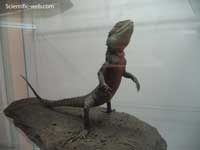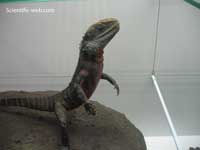Physignathus lesueurii, Physignathus lesueurii,
The Australian Water Dragon or Eastern Water Dragon, Physignathus lesueurii, is an arboreal agamid species native to Eastern Australia from Victoria north to Queensland, there is also a small population in the South-East coast of the State of South Australia. Description Australian water dragons have long powerful limbs and claws for swimming and climbing, and have a prominent nuchal and vertebral crest. (A nuchal crest is a central row of enlarged spikes at the base of the head. These spikes continue down the spine, getting smaller as they reach the base of the tail.) [1] Including their tails, which comprise about two-thirds of their total length, adult females grow to about 2 feet (60 centimetres) long, and adult males can grow slightly longer than 3 feet (one metre). Males show bolder coloration, with red chests and larger heads than females. [2][3] Color is less distinct in juveniles.[1] Species variation The Australian Water Dragon is the only species of the genus Physignathus in Australia. The other species, Physignathus cocincinus, lives in South-East Asia. There are two subspecies of Physignathus lesueurii: P. l. lesueurii (Eastern Water Dragon) and P. l. howitti (Gippsland Water Dragon). P. l. lesueurii possesses a dark band behind its eye; P. l. howitti lacks this and instead has dark bands on either side of its throat, which is blotched with yellow, orange, or blue. Both subspecies are light greenish grey in overall color with black bands running across their back, tail and legs. Habitat As its name suggests, the Australian water dragon likes to live near water. It can be found near creeks, rivers, lakes and other water bodies that also have basking sites such as overhanging branches or rocks in open or filtered sun. The species is so common in the rainforest section of Brisbane Botanic Gardens, Mount Coot-tha in Queensland that a monument has been built to them there. Feeding Water dragons eat a wide variety of insects (aquatic and terrestrial), molluscs, small fish and turtle hatchlings, native fruit, and they will scavenge around picnic areas and urban parks. [4] Breeding Australian water dragons hibernate over winter. During spring, usually in early October, the female digs a burrow about 4-6 inches (10-15 centimetres) deep and lays between 6 and 18 eggs.[4] This nest is in sandy or soft soil, in an area open to sun. When the mother has laid the eggs, she backfills the chamber with soil and scatters loose debris over it. When the young are born they stay near the entrance of the burrow for some time before leaving home. When they finally leave the nest, they tend to group together away from the adult population. [2] References 1. ^ Australian National Botanic Gardens External links
Retrieved from "http://en.wikipedia.org/"
 |
|
||||||||||||||||||||||||||||||||||||||

